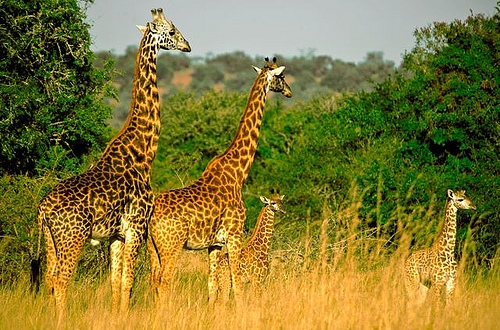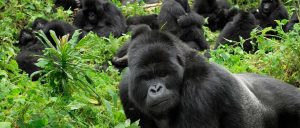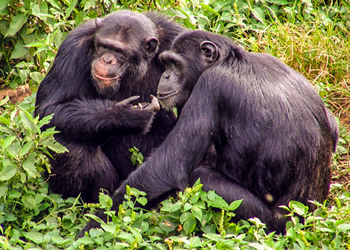
Akagera National Park was named after the river that flows along its eastern boundaries and is Rwanda’s gifted park in relation to the famous savanna reserves of Kenya and Tanzania. Much as most of Rwanda is not warm, this park is located in a relatively warm and an area with a lower latitudinal range of undulating plains supporting a cover of dense, broad-leafed woodland interspersed with lighter acacia woodland and patches of rolling grassland studded evocatively with stands of the superficially cactus shrub. To the west of the plain lies a chain of low mountains, reaching elevations of between 1600m and 1800m above sea level. The eastern part of the park supports an extensive wetland: a complex of a dozen lakes linked by extensive papyrus swamps and winding water channels fed by the meandering Akagera River.
In terms of game viewing, it would be misleading to compare Akagera to East Africa’s finest savanna reserves. The northern and western portions of the original 2500sqkm park were degazetted in 1997 in a bid to accommodate returned refugees, reducing the protected area to 1085sqkm. Given that the inhabitants and surrounding communities were hunters, there is still poaching around and in the park which has impacted negatively on wildlife populations, and those lakes that remained within the national park were until recently used to water domestic cattle-indeed, a few years back, long horned Ankole cows were the most commonly seen large mammal in Akagera National Park
Akagera National Park today still ranks among the most scenic of Africa’s remaining savanna reserves and very much worth visiting. For one thing it ranks among the, with its sumptuous forest-fringed lakes, tall mountains and constantly changing vegetation. On top of that, the birdlife is quite phenomenal-for specialist birders, the checklist of almost 500 species includes several rarities, whilst for first time African visitors, it’s a great place to see eagles and other large raptors along with some truly impressive concentrations of water associated birds.
Akagera also still retain a genuinely off-the-beaten-track character: this is one African game reserve where you can still drive for hours without passing another vehicle, never knowing what wildlife encounter might lie around the next Corner. And contrary to some reports, there is plenty of wildlife around, with the likes of zebra, giraffe, hippo, baboon, warthog and half-a-dozen antelope species all reasonably visible and less skittish than one might expect. In addition, the lakes support some of the highest concentration of hippo you’ll find anywhere in Africa, as well as numerous large crocodiles.
As for the coveted big five, buffalo are plentiful and easily seen, elephants are quite common but more difficult to track down, and leopards are present but secretive as ever. www.interiorsafarisea.com
Day 1: Arrival at Kigali International Airport
You will be met by your tour guide on arrival at the airport and drive to the East, through the beautiful undulating plains, composed of dense, broad-leafed woodland, lighter acacia woodland and rolling grassland, also with an extensive series of lakes linked by papyrus swamps forming a sprawling wetland, check-in Akagera Safari lodge for dinner and overnight.
Day 2: Akagera National Park Game drive
An early start this morning as you join your ranger in an open vehicle for your safari into the Akagera National Park. A half day game drive offers you the opportunity to spot a variety of wild animals such as elephants, buffalos, lions, Masai giraffe, gazelles, impala, baboons, oribi, Butchel’s zebra, topi, bush baby, leopard and bushbuck. Return to the lodge for lunch.
Proceed for a boat trip after along Lake Ihema, where you will have a closer look on water animals like Crocodiles and Hippos, coupled with large concentration of bird life; over 525 species identified. Unique species such as Shoe billed stocks and papyrus gonolek can be encountered. Endemics include the jacanas, ibis, sand pipers and herons.
Return to your lodge for dinner and a chance to discuss today’s sightings!
Day 3: Akagera – Volcanoes National Park
Start an early drive this morning after breakfast; return to Kigali and connect to Park National des Volcans (PNV) in the north for an absolutely unparalleled experience of Mountain gorilla tracking. Check-in at mountain Gorilla’s Nest or Kinigi Guest House near Kinigi station – Park Headquarters for lunch.
Take a walk through nearby forests to nearby crater lakes for scenic viewing, bird watching and photography. Dinner and overnight at Mountain Gorilla’s Nest/Kinigi guest house.
Day 4: Gorilla tracking in Volcanoes National Park Rwanda 
At 7:00 am local time, breakfast at the lodge will be ready. 30 minutes will be enough for your breakfast and then transfer to the nearby park headquarters where you will be briefed by park ranger on how to carry out gorilla tracking
Hiking on the slippery and muddy Volcanoes slopes with nettles is quite challenging. But the encounter with mountain gorillas erase all the bad memories! You will be allowed to stay with these close relatives of man (mountain Gorillas) for at least an hour for observation and photography.
In the evening visit the panoramic twin volcanic lakes of Burera and Ruhondo. Return to your lodge for dinner and folk tales at the fire place.
Day 5: Final Day of the Safari
After an early morning break fast, embark on a half day hike to Mt Bisoke, which is topped with a beautiful crater lake, take photos and later connect to Kigali International Airport for your flight back home.
End of the tour

